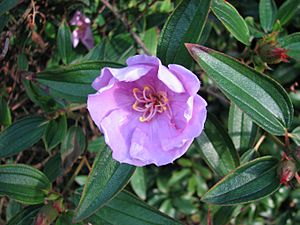Blue tongue facts for kids
Quick facts for kids Blue tongue |
|
|---|---|
 |
|
| Scientific classification | |
| Genus: |
Melastoma
|
| Species: |
affine
|
| Synonyms | |
Melastoma affine, also known as the blue tongue or native lassiandra, is a beautiful shrub that belongs to the Melastomataceae plant family. You can find this plant growing in warm, wet forests across India, Southeast Asia, and Australia. It often grows on the edges of rainforests. Bees are very important for helping this plant make seeds.
Contents
About the Blue Tongue Plant
The name Melastoma affine was first given to this plant by a Scottish botanist named David Don in 1823. Scientists sometimes find it tricky to sort out all the different types of Melastoma plants. They use genetics to help understand how these plants are related.
What are Synonyms?
In science, a "synonym" is another name that has been used for the same plant. As of November 2020, the Australian Plant Census (APC) accepts these other names for Melastoma affine:
- Melastoma malabathricum var. nanum
- Melastoma malabathricum var. polyanthum
- Melastoma novae-hollandiae
- Melastoma polyanthum
What Does It Look Like?
This plant grows as a shrub, usually up to about 2 meters (6.5 feet) tall. Its leaves are shaped like an oval and are about 6 to 12 cm (2.5 to 4.5 inches) long and 2 to 4 cm (1 to 1.5 inches) wide. They feel a bit hairy and have special veins that run lengthwise.
Flowers and Fruit
In spring and summer, you can see beautiful purple flowers on the ends of the branches. Each flower has five petals and five sepals (which are like small leaves under the petals). The flowers have two sets of unique stamens, which are the parts that hold pollen.
After the flowers, the plant grows small purple fruits, about 8 mm long. These fruits split open to show a reddish to purple inside with many tiny seeds. The common name "blue tongue" comes from this purplish-black fruit pulp. If you eat it, it can stain your mouth blue!
Where Does It Grow?
Melastoma affine is found in many places, from India through Southeast Asia, Malaysia, Indonesia, and all the way to Australia. In Australia, it grows in the Kimberleys (Western Australia), across the Northern Territory, Queensland, and as far south as Kempsey in New South Wales. It likes to grow in wet areas, often in sclerophyll forests.
A Pioneer Plant
This plant is important because it's a "pioneer species." This means it's one of the first plants to grow in places that have been disturbed, like after a fire or a storm. It helps new rainforest and wet-sclerophyll areas start to grow back.
How Bees Help
Melastoma affine doesn't make nectar, which is a sweet liquid many flowers produce. Instead, it gives bees lots of pollen. Bees have to buzz in a special way to get the pollen out of the flower's anthers (the pollen-holding parts). Many types of bees pollinate this plant, including the Peacock carpenter bee and Nomia species.
Growing Your Own Blue Tongue Plant
The blue tongue plant is a fast-growing and easy-to-adapt shrub. Sometimes, people grow it in their gardens. You can start new plants from its seeds or by taking cuttings from an existing plant.
See also
 In Spanish: Melastoma affine para niños
In Spanish: Melastoma affine para niños

